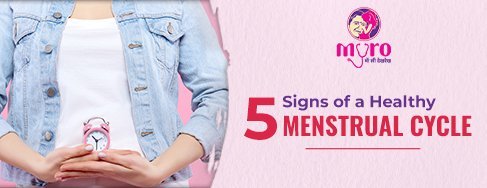
5 Signs of a Healthy Menstrual Cycle
While there is no such thing as a perfect menstrual period, there are several signs of a healthy menstrual cycle. Furthermore, our menstrual periods may tell us a lot about what is going on in our bodies and our overall health.
Unfortunately, most women have never been taught the language in which their bodies respond, much alone how to understand the often-confusing signals they communicate. One of the greatest ways for women to take responsibility for their endocrine health is to start carefully noticing and noting numerous menstruation signs and symptoms each month.
Here are some of the most often inquiries I hear regarding menstrual health and how to tell whether you have a healthy menstrual cycle.
Healthy Menstrual Cycle
Your menstrual cycle is between 26-35 days.
Ideally, your menstrual cycle should be between 26-35 days long and about the same length every month. The total length of the cycle is counted from the first day of the proper flow of your period to the last day before your next period. Cycles that are irregular in length by more than five days or shorter or longer than 26-35 days can be an indication that your hormones are out of whack.
How long should your menstrual cycle be?
The length of your menstrual cycle should be between 25 and 35 days. It should be the same duration each month and not vary. In other words, if you have a period that lasts 29 days one month, 34 days the next, and 26 days the next, you may be experiencing abnormal hormonal changes.
If your cycle is shorter than 25 days, you may have Luteal Phase Defect1, which is characterized by a brief luteal phase (the second half of your cycle after ovulation). This illness is often characterized by an estrogen dominance hormonal imbalance, in which estrogen levels increase excessively high in comparison to progesterone levels.
If your period lasts more than 35 days, you may have a disease that delays or prevents ovulation: The most prevalent causes are polycystic ovarian syndrome and a lack of ovulation, which results in a lack of periods.
In any of these circumstances, you should see your doctor to find out what’s wrong with your hormones. A healthy period denotes a healthy body and mind.
Also Read: – https://myroclinic.com/postmenopausal-bleeding/
5 Signs of A Healthy Menstrual Cycle
The blood is a healthy red color.
The blood in your menstruation should be a deep red color (kind of like cranberry juice). This indicates that enough blood flow to your pelvic area is there and that blood is not stagnating in the uterus.
Dark red blood, brown blood, or clots, on the other hand, may be produced by a slow flow and/or inadequate uterine circulation. These difficulties might potentially be the result of an underlying hormonal imbalance (usually estrogen dominance).
To increase blood flow in cases of blood stagnation, I propose using a hot water bottle or a castor oil pack directly to the belly.
Abdominal cramps
Menstrual cramps (dysmenorrhea) are throbbing or cramping sensations in the lower abdomen. Many women have menstrual pains shortly before and throughout their periods.
For other women, the pain is only irritating. For some, period cramps might be strong enough to disrupt daily activities for a few days each month.
Endometriosis and uterine fibroids are two conditions that may cause menstrual cramps. Reducing pain requires addressing the underlying cause. Menstrual cramps that aren’t caused by another condition tend to improve with age and are frequently better after delivering the child.
Breakouts
You should only bleed during your period and not at other times in your cycle. Irregular bleeding, commonly known as “breakout bleeding,” that occurs outside of your period days (during your luteal phase) may suggest insufficient progesterone, a lack of ovulation, or estrogen dominance. The hormone progesterone keeps your uterine lining intact until the conclusion of your cycle when it drops and causes the endometrium to shed.
There is one exception to this rule that occurs during ovulation. Some women experience ovulatory bleeding (a sign that ovulation is happening), which typically lasts from one to two days and resembles very light spotting. Don’t panic if this happens; it is actually very normal.
To help yourself keep tabs on potential irregularities in your cycle, I recommend using a period-tracking app like Kindara, iPeriod, Flo, or Period Tracker to record all the data you collect during each cycle.
Taking a little extra time to check in with your body gives you a chance to recognize abnormalities and take steps to address them effectively. Hopefully, these five important clues will help you get started on the journey to balanced hormones!
Takeaway
There are many wonderful meals to consume during your period to help you get over the monthly pain and discomfort. To improve digestion and recover what is lost during menstruation, avoid sugary, salty, and fatty snacks in favor of heart-healthy, high-fiber meals loaded with fruits and vegetables.
Cooking veggies at a low to medium temperature helps to retain as many nutrients as possible. To get the most out of them, avoid deep-frying them or using too much butter or oil; instead, grill, roast, or simmer them.
Finally, don’t miss meals when on your period since it aggravates nausea and exhaustion. When feasible, use natural, unprocessed items, and drink enough water to keep hydrated and efficiently control your PMS symptoms
If you are looking for a gynaecologist consult Dr. Satyamvada Pandey is the best gynaecologist in Jaipur. She has been in the profession for more than 15 years and is a well-known senior obstetrician consultant at Myro Clinic.